AP Biology 2013 Summer Assignment .pdf - Midlothian ISD
AP Biology 2013 Summer Assignment .pdf - Midlothian ISD
AP Biology 2013 Summer Assignment .pdf - Midlothian ISD
You also want an ePaper? Increase the reach of your titles
YUMPU automatically turns print PDFs into web optimized ePapers that Google loves.
Welcome to the <strong>AP</strong> <strong>Biology</strong> “<strong>Summer</strong> of <strong>Biology</strong>” <strong>2013</strong> Dun....dun...dun...dun...dun... . Is it safe to go back in the water? NO! Like a shark, there lurks…. the <strong>AP</strong> <strong>Biology</strong> <strong>Summer</strong> <strong>Assignment</strong>! Ahhhhhhhh! This summer you will delve into the world of biology like you never thought you would in those hot months! We will explore many topics to whet your appetite for the coming year of hard work. This summer assignment has been designed for five purposes: • To introduce yourself to me so that I can get a better understanding of you, your expectations and your learning style. • To get you to think during those summer months to keep your mind sharp, because I will expect a lot out of it come August! • To expand your vocabulary by familiarizing you with terms that we will be using in class. • To introduce you to major concepts from <strong>AP</strong> <strong>Biology</strong> through non-‐classroom methods of learning. • To prepare you for the busy year ahead and ensure that you are prepared to begin the very first day! ASSIGNMENT # 1 LETTER OF INTRODUCTION We are going to spend a lot of time together next year, so it’s best if I get a head start on learning a bit about you. Also we will use the Internet, Blackboard and the Web a lot next year for this course, so let’s get you used to communicating with your teacher via e-‐mail. Your first digital assignment is to successfully send an email to your <strong>AP</strong> <strong>Biology</strong> teacher. Due date: Monday, July 8 th Draft an email to me following these rules: a. Use clearly written, full sentences. Do not abbreviate words like you are on AIM with a friend. Use spell check! This is a professional communication like you would have with a college professor, so let’s practice for your rapidly nearing future! b. Address it to the appropriate teacher: jennifer_ferranti@midlothian-‐isd.net (do not forget the underscore _ between the first and last names. c. Make the Subject: “<strong>AP</strong> Bio: Introduction to ” (Do not include the quote marks or the brackets, just the words) d. Begin the e-‐mail with a formal salutation, like “Ms. Ferranti,” or “Dear Ms. Ferranti,” e. Now introduce yourself (your name) and tell me a little bit about yourself, like: What do you like to do (hobbies, sports, music, interests, etc.)? Do you have a job? Etc… f. Then please tell me about your science background: Was there anything that you liked about your earlier biology class? What is your reason for signing up for <strong>AP</strong> <strong>Biology</strong>? What are you looking forward to the most in <strong>AP</strong> <strong>Biology</strong>? What are you most anxious about in <strong>AP</strong> <strong>Biology</strong>? g. End the e-‐mail with a formal closing: “Cordially”, “Sincerely”, “Warm regards”, etc. and add your name as if you signed a letter. See, that wasn’t so bad, maybe this is going to be okay after all!
ASSIGNMENT # 2 BIOLOGY COLLECTION For this part of your summer assignment, you will be familiarizing yourself with science terms that we will be using at different points throughout the year. 1. Each item is worth 2 points. You must earn 100 points by Friday August 31. 2. Earn 100 points by “collecting” 50 items from the list of terms. When I say “collect”, I mean you should collect that item by finding it and taking a photograph (digital or paper printed) of the item. You will post your ‘photographs’ in an electronic file (powerpoint or otherwise) along with the definition of the word you have chosen and email it to my address before the due date. 3. YOU CAN BE CREATIVE: If you choose an item that is internal to a plant or animal, like the term “phloem”, you cannot submit a photograph of the whole organism. You can, however, submit a close up of one part, and then explain under the photo what phloem is and specifically where phloem is in your specimen. 4. NATURAL ITEMS ONLY: All items must be from something that you have found or normally see in nature. Take a walk around your yard, neighborhood, and town. DON’T SPEND ANY MONEY! Research what the term means and in what organisms it can be found... and then go out (or in) and find an example. BIOLOGY COLLECTION TERMS Below are the items you are to “collect”. An individual organism can only be used once. Humans are acceptable for one category only. Each specimen is worth 2 points. You may only have 1 example of each item; submitting more than 1 will not add any additional points. adaptation of a plant adaptation of an animal allopatric isolation altruistic behavior amniotic egg analogous structure angiosperm anther & filament of a stamen archeabaceria asexual reproduction ATP autotroph auxin Batesian mimicry bilateral symmetry biological magnification bryophyte C3 Plant C4 Plant CAM Plant cellular respiration cline coevolution commensalism counter current exchange detrivore directional selection disruptive selection dominant phenotype ectotherm endotherm enzyme epistasis epithelial tissue ethylene eubacteria eukaryote fermentation gametophyte gibberellins glycogen GMO genetically modified organism gymnosperm heterotroph homeostasis homologous structures hydrophilic hydrophobic K-‐strategist (K-‐selected species) keystone species kinesis (insect or animal) lipid Mullerian mimicry mutualism mycelium mycorrhizae niche parasitism pleiotropy population predation primary succession prokaryote r-‐strategist (r-‐selected species) radial symmetry (animal) rhizome secondary succession sporophyte stabilizing selection sympatric isolation taxis territorial behavior tropism vestigial structures
ASSIGNMENT # 3 (I would print this and fill in the information requested) Macromolecule Web Quest – <strong>AP</strong> <strong>Biology</strong> covers a lot of material, and you will be responsible for learning how to process and understand that material effectively. This web quest will require internet access. If you don’t have a computer or internet available to you at home, <strong>Midlothian</strong> Public Library has got you covered! Macromolecules WebQuest Section 1: Macromolecules Tutorial Here you will click through a series of four tutorials about the four major types of macromolecules. Use the website listed below to answer the following questions. A. Open the website http://bcs.whfreeman.com/thelifewire/content/chp03/0302002.html B. Start by reading the introduction. 1. What are the four main types of macromolecules? __________________ _____________________ 2. What is a polymer? __________________ ___________________ 3. List the monomers that are linked together to form each of the following macromolecules: Proteins __________________ Carbohydrates __________________ Nucleic acids __________________ C. Click on the tab at the top of the page called Animations. Ø Click the box labeled “step-‐through” Ø Click on “CARBOHYDRATES” first. Ø There are 6 separate pages for the carbohydrate module. After you readeach page, click “continue”, and then “play” to watch the animation. 1. __________________ is a hexose, a sugar composed of __________________ carbon atoms, usually in __________________ form. 2. How many glucose monomers are there in a single starch molecule? __________________________ 3. Glucose molecules can be added to starch by a __________________________ reaction, where two molecules__________________________ bond together and release a __________________________ molecule. 4. Which is more highly branched, Amylose (plant starch) or Glycogen (in animal livers and fat)?
5. __________________________ are hydrolyzed (broken apart) to form glucose, and glucose is then further broken down to release __________________________. D. Click on “Options” Ø Click on “LIPIDS”. Ø There are 7 separate pages for the lipid module. After you read eachpage, click “continue”, and then “play” to watch the animation. 1. What is a triglyceride composed of? 2. Why is Palmitic acid called a saturated fatty acid? 3. What makes oleic acid a monounsaturated fatty acid? 4. How many double bonds are there in a polyunsaturated fatty acid? _________________________ 5. Why are polyunsaturated fatty acids often liquid at room temperature? 6. Compare the shape of the carbon chain in a saturated fatty acid, a monounsaturated fatty acid, and a polyunsaturated fatty acid. Draw a rough sketch of the three chains below. Saturated Monounsaturated Polyunsaturated E. Click on “Options” at the bottom of the page. Ø Click on “Proteins” Ø There are 6 separate pages for the proteins module. After you read each page, click “continue”, and then “play” to watch the animation. 1. Proteins are chains of _______________________ linked by _______________________. 2. The 20 different amino acids used to make all proteins differ only in their _______________________. 3. A protein’s amino acid sequence determines its _______________________ and _______________________. 4. What is collagen?
F. Click on “Options” at the bottom of the page. Ø Click on “Nucleic Acids” Ø There are 6 separate pages for the nucleic acids module. After you read each page, click “continue”, and then “play” to watch the animation. 1. What are the two types of nucleic acids? ____________________ and ____________________ 2. What do nucleic acids have the ability to do within the cell? 3. When two strands of DNA pair by hydrogen bonding, the base ______________________ always pairs with ____________________, and ____________________ always pairs with ____________________. 4. Draw a rough sketch of the three parts of a nucleotide below. 1. ____________________ 2. ____________________ 3. ____________________ 5. In DNA, base pairing occurs only between a ____________________ and a ____________________ . 6. Fill in the table below with the appropriate names of the nitrogen bases: Purine DNA complimentary base pairs Pyrimidine G. Click on the tab at the top of the page called Conclusion. Ø Read the conclusion. 1. A macromolecule’s structure is intimately connected to its _______________________. 2. List one function of each macromolecule below: Nucleic Acid __________________________________________________________ Carbohydrate __________________________________________________________
Protein __________________________________________________________ Section 2: Macromolecules in 3D Here you will browse through several 3D images of different macromolecules. Study the images to find features that you learned about in the previous tutorial. A. Visit the website http://www.nyu.edu/pages/mathmol/library/life/ B. Click on the link called Sugar Molecules Ø Browse through the different 3D images of carbohydrate molecules. Ø In order to view an image, always click on the small link Gif above the picture. DO NOT click VRML or PBD. C. Click on the link called Lipids at the bottom of the screen. Ø Browse through the different 3D images of lipid molecules. Ø In order to view an image, always click on the small link Gif above the picture AND the small link Info above the picture to learn more about the molecule. 1. Categorize the different lipid molecules as saturated, monounsaturated or polyunsaturated. 2. How could you tell from viewing the 3D images? D. Click on the link called Amino Acids at the bottom of the screen. These are the small building blocks of proteins! Ø Browse through the different 3D images of amino acids. Ø In order to view an image, always click on the small link Gif above the picture AND the small link Info above the picture to learn more about the molecule. E. Click on the link called Nucletides at the bottom of the screen. Ø Browse through the different 3D images of Nucleotides and Nucleic acids. BE SURE TO CLICK ON THE DNA MOLECULE! Ø In order to view an image, always click on the small link Gif above the picture AND the small link Info above the picture to learn more about the molecule. Congratulations, you survived Macromolecules 101!
<strong>AP</strong> BIOLOGY SUPPLIES Please use the summer as your opportunity to get your supplies for <strong>AP</strong> <strong>Biology</strong> early! Try to come in prepared on Day 1. MATERIALS 1. 3-‐ring class notebook/binder 2. Blue or black pens and pencils to be brought to class EVERY day 3. Textbook (from the library): Campbell <strong>Biology</strong> (9th Edition) The textbook should be left at home for your homework unless otherwise instructed. 4. <strong>AP</strong> <strong>Biology</strong> Review Book -‐ I recommend the Cliff’s <strong>AP</strong> <strong>Biology</strong> but any current <strong>AP</strong> Bio workbook will suffice. If you are unsure, email me the title and I will give you some input if I have any. You will need this throughout the year. You might want to find a past student to see if you can buy theirs cheap! They usually run about $20.00 OPTIONAL MATERIALS ( We may use these occasionally throughout the year) 1. Notecards 2. Highlighters 3. Graph paper (3-‐4 times per semester) 4. 4 colors of pen or pencil That’s it! If I were you, I wouldn’t put this off to long. It can really sneak up on you, also, please get in touch with me if you have any questions. I will be checking my email regularly. Good Luck and we look forward to seeing you in the Fall! Jennifer Ferranti


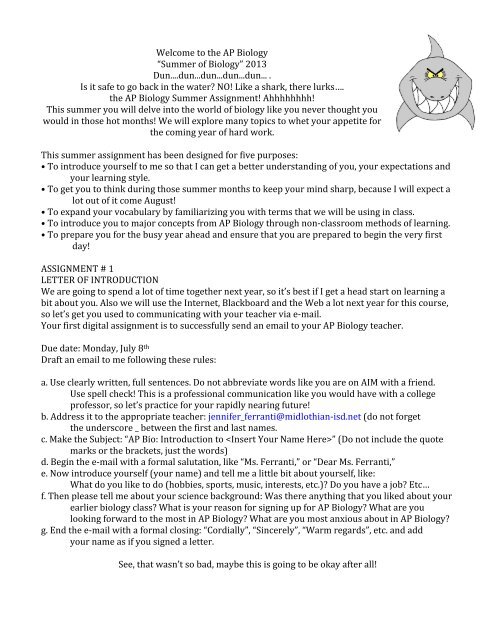
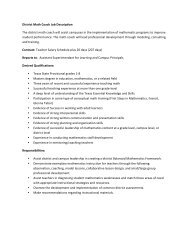

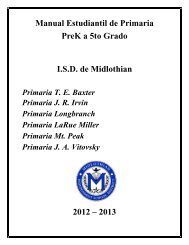

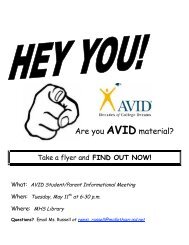

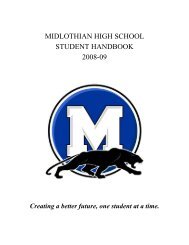

![Course Catalog [PDF] - Midlothian ISD](https://img.yumpu.com/36431290/1/190x245/course-catalog-pdf-midlothian-isd.jpg?quality=85)




